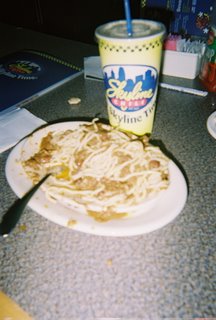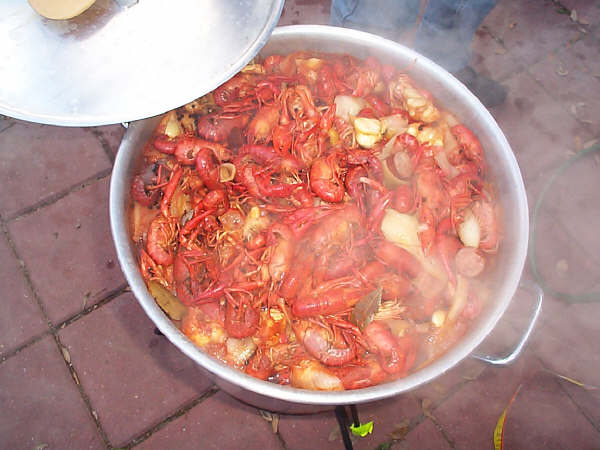Fast Food in the Buckeye State
Out of town again this past weekend, I was able to indulge in one of my favorite (if not healthiest) pastimes: sampling other regions' fast food chains. It's hard to get interested in the big national chains (McDonald's, Taco Bell, The Hated Burger King, etc.) but the smaller chains can be as quirky and interesting as mom'n'pop shops.
Upon landing in Columbus, we asked the pleasant-if-none-too-quick teenager at the Alamo rental desk for directions to the nearest White Castle. Columbus is, of course, the ancestral home to America's finest mini-burger chain, and we didn't waste give minutes in our pursuit of a sack of sliders. (I say "we," but of course The Wife ate only one burger, bitched loudly about it, and refused to eat another.)
 I hadn't had a slider in about five years, which is right on schedule, from a cardiologist's perspective. White Castle sticks to its classic formula: small, thin patties covered with onion bits and steamed into the soft, freshly-baked bun with just a pickle to liven the deal. (Though, of course, you can aske for ketchup or mustard or both.) Why mess with perfection? Admittedly, they don't taste a whole lot like meat, or even like hamburgers, as we commonly understand the term. But they fulfill a certain need. (As do the "chicken rings," but that's another story.) Verdict: Awesomely delicious, if not, you know, particularly healthy.
I hadn't had a slider in about five years, which is right on schedule, from a cardiologist's perspective. White Castle sticks to its classic formula: small, thin patties covered with onion bits and steamed into the soft, freshly-baked bun with just a pickle to liven the deal. (Though, of course, you can aske for ketchup or mustard or both.) Why mess with perfection? Admittedly, they don't taste a whole lot like meat, or even like hamburgers, as we commonly understand the term. But they fulfill a certain need. (As do the "chicken rings," but that's another story.) Verdict: Awesomely delicious, if not, you know, particularly healthy.If you ever listen to Astros games on the radio, you're no doubt familiar with the mellifluous tones and dry wit of Milo Hamilton, one of the best play-by-play guys in the business. Milo has certain likes and dislikes about the cities he visits, and one of his peeves about Cincinnati -- Queen City to her fans -- is Skyline Chili, an institution in southern Ohio which Milo once denounced on air as "the worst thing I've ever eaten."
Naturally, this was like a red flag to a bull for your loyal blogger. We had to visit.
 And we did: we dropped in on the Lebanon, OH branch for a late lunch on the way to our friends' wedding. Suffice to say, this ain't your typical Texas bowl of red. Skyline's "original secret recipe chili" (as it's referred to exclusively in the menu) is a thin, greyish sauce with finely-ground "beef" and a distinctly sweet, oddly Christmas-y flavor. There are, apparently, two classic ways to enjoy Skyline Chili: over spaghetti with finely-shredded cheddar cheese and onions (a "classic three way," which sounds dirty) or on a small coney-style hot dog. As the relationship columnists advise, the three-way is a terrible idea. Mushy spaghetti with a grey, cinnamon-flavored meat gruel on top just isn't worth the long-term damage it causes. The "Cheese Mett Coneys" are better, if you scrape off the top two inches of cheese (leaving you with a still-robust solid inch of cheese) and try not to think about Nathan's or James Coney Island. And the restaurant itself -- with counter service and 400-lb. waitstaff -- is actually rather pleasant and quite clean for a fast food joint. Verdict: Worth a visit, if only to see what passes for chili in the heartland.
And we did: we dropped in on the Lebanon, OH branch for a late lunch on the way to our friends' wedding. Suffice to say, this ain't your typical Texas bowl of red. Skyline's "original secret recipe chili" (as it's referred to exclusively in the menu) is a thin, greyish sauce with finely-ground "beef" and a distinctly sweet, oddly Christmas-y flavor. There are, apparently, two classic ways to enjoy Skyline Chili: over spaghetti with finely-shredded cheddar cheese and onions (a "classic three way," which sounds dirty) or on a small coney-style hot dog. As the relationship columnists advise, the three-way is a terrible idea. Mushy spaghetti with a grey, cinnamon-flavored meat gruel on top just isn't worth the long-term damage it causes. The "Cheese Mett Coneys" are better, if you scrape off the top two inches of cheese (leaving you with a still-robust solid inch of cheese) and try not to think about Nathan's or James Coney Island. And the restaurant itself -- with counter service and 400-lb. waitstaff -- is actually rather pleasant and quite clean for a fast food joint. Verdict: Worth a visit, if only to see what passes for chili in the heartland.

